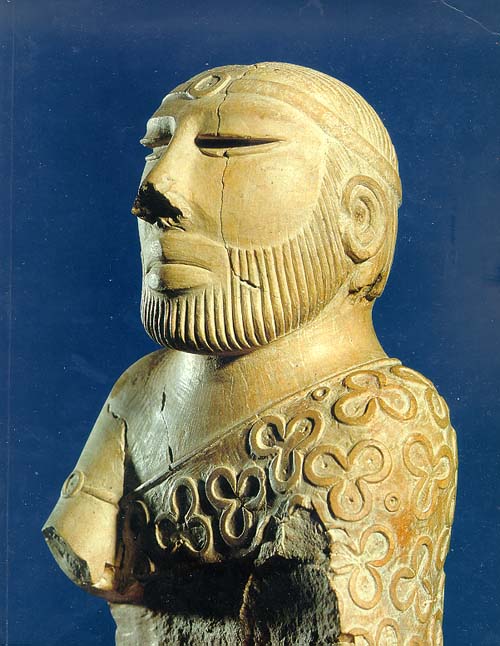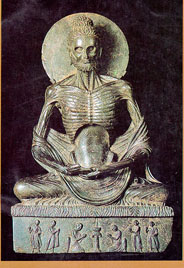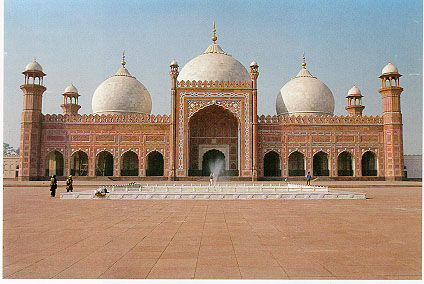Official Name : Islamic Republic of Pakistan
Father of the Nation : Quaid-i-Azam Muhammad Ali Jinnah
Head of the State : Pervez Musharaf
Capital : Islamabad
Area : 796,095 Sq. km.
Punjab: 205,344
Sindh: 140,914
North West Frontier Province: 74,521
Balochistan: 347,190
Federally Administered Tribal Areas: 27,220
Islamabad(Capital): 906
Population : 135.28 million
Religious composition : 95% Muslims, 5% others
Per capita income : US$ 460
Currency : Pak Rupee
Exports : Cotton, textile goods, rice, leather items carpets, sports goods, fruits, handicrafts Sea Food (Fisheries)
Imports : Industrial equipment, vehicles, iron ore, petroleum, edible oil
Languages : Urdu (National language)English (Official)
Literacy rate : 38.9%
Pakistan National Flag : Dark green with a white vertical bar, a white crescent and a five-pointed star in the middle. The Flag symbolizes Pakistan's profound commitment to Islam and Islamic world.
National Anthem : Approved in June, 1954
Verses Composed by: Abul Asar , Hafeez Jullundhri
Tune Composed by: Ahmed G. Chagla
Duration: 80 seconds
State Emblem :
The State Emblem consists of:
The crescent and star which is symbol of Islam.
The shield in the centre shows four major crops.
Wreath surrounding the shield represents cultural heritage.
Scroll contains Quaid's motto: Unity Faith, Discipline.
National Flower : Jasmine
Flora : Pine, Oak, Poplar, Deodar, Maple, Mulberry
Fauna : The Pheasant, Leopard, Deer, Ibex, Chinkara, Black buk, Neelgai, Markhor, Marcopolo sheep, Green turtles, River & Sea fish, Crocodile, Water Fowls
Popular games : Cricket, Hockey, Football, Squash
Tourist's resorts : Murree, Quetta, Hunza, Ziarat, Swat, Kaghan, Chitral and Gilgit
Archaeological sites : Moenjo Daro, Harappa, Taxila, Kot Diji, Mehr Garh
Major Cities : Islamabad, Karachi, Lahore, Peshawar, Quetta, Rawalpindi, Hyderabad, Multan, Sialkot and Faisalabad
Agriculture : Major crops are cotton, wheat, rice and sugarcane
Total cropped area : 22.14 million hectares
Industry : Textiles, cement, fertiliser, steel, sugar, electric goods, shipbuilding
Energy :
Major sources:
Oil, Coal, Hydel, Thermal, Nuclear and Liquid Petroleum Gas ,WAPDA's total installed power generating capacity: 11,246 MW
Health :
Hospitals: 830
Beds: 86,921
Doctors(registered): 74,229
Dentists(registered): 2,938
Nurses(registered): 22,810
Education :
Primary schools: 150,963
Middle schools: 14,595
High schools: 9,808
Arts & science colleges: 798
Professional colleges: 161
Universities: 35 (10 in Private sector)
Transport & Communication :
Total length of roads: 228,206 km
Pakistan Railway network: 8,775 km
Railway stations: 781
Pakistan International Airlines: Covers 55 international and 38 domestic stations
Major Airports: 6 - Islamabad, Karachi, Lahore, Quetta, Peshawar and Gwadar
Seaports :
International : 2 - Karachi and Bin Qasim
Domestic: 3 - Minora, Gwadar and Pasni
Communications :
Post Offices: 13,419
Telephone connections: 2.47 million
Public Call Offices: 10,000
Telegraph offices: 427
Employment :
Total Labour force: 37.15 million
Agriculture sector: 47%
Manufacturing & Mining sector: 10.50%
Others: 42.50%
Media :
Print Media
Dailies: 424
Weeklies: 718
Fortnightlies: 107
Monthlies: 553
News Agencies
APP (official)
PPI & NNI (Pvt)
Electronic Media
Pakistan Television: Five TV centres at Islamabad, Lahore, Peshawar, Quetta and Karachi covering 87% population
Registered TV sets: 2,823,800
Viewership: 115 million
Radio stations: Total 23, Home services in 20 languages, External services cover 70 countries in 15 languages
Private TV/Radio: Radio stations 3, TV transmitter channels 2, Private News Agencies 2
Indus Vision
Stn
ARZ
Banks :
Central Bank: State Bank of Pakistan
Other Banks: National Bank of Pakistan, Habib Bank Ltd., Muslim Commercial Bank Ltd., Allied Bank of Pakistan Ltd., First Woman Bank, Mehran Bank and the Bank of Punjab
Specialised Banks: Agricultural Development Bank of Pakistan, Federal Bank for Co-operatives, Industrial Development Bank of Pakistan, The Punjab Provincial Co-operative Bank, Banker's Equity and National Development Finance Corporation
Famous Mountain Peaks :
K-2 (Mt. Godwin Austin): 28,250 ft./8611 m (2nd in World)
Nanga Parbat : 26,660 ft./8126 m (8th in World)
Gasherbrum-I: 26,470 ft./8068 m (11th in World)
Famous Mountain Passes : The Khyber Pass, The Kurram Pass, The Tochi Pass, The Gomal Pass, The Bolan Pass, The Lowari Pass, & The Khunjrab Pass
Rivers :
The Indus: 2896 km
Jhelum: 825 km
Chenab: 1242 km
Ravi: 901 km
Sutlej: 1551 km
Beas (tributary of Sutlej): 398 km
Famous Glaciers :
Siachin: 75 km
Batura: 55 km
Baltoro: 62 km
Deserts :
Thar: Sindh
Cholistan: Punjab
Thal: Punjab
Lakes :
Manchar(Sindh), Keenjar(Sindh), Hanna(Balochistan), Saif-ul-Maluk(NWFP), Satpara(Northern Areas), & Kachura(Northern Areas)
Major Dams :
Mangla Dam(Punjab), Tarbela Dam(North West Frontier Province), & Warsak Dam(North West Frontier Province)











































